The pixie haircut has evolved from a classic style into a modern fashion statement that combines sophistication with effortless charm.
When you think about transforming your appearance with minimal maintenance and maximum impact, messy pixie haircuts stand at the forefront of contemporary hairstyling trends.
This comprehensive guide to the Best 30 Messy Pixie Haircuts Elevate Your Look will walk you through diverse variations, styling techniques, and expert recommendations that suit different face shapes, hair textures, and personal preferences.
Whether you’re considering a dramatic change or looking to refresh your current pixie cut, you’ll discover inspiring options that range from subtly tousled to boldly textured, each designed to enhance your natural features while expressing your unique personality.
From understanding the fundamentals of messy pixie cuts to exploring specific styling methods and maintenance routines, this article provides everything you need to make an informed decision and achieve a stunning new look that turns heads wherever you go.
Contents
- 1 1. Classic Tousled Pixie with Textured Layers
- 2 2. Asymmetrical Messy Pixie with Side Swept Bangs
- 3 3. Choppy Pixie with Razor Cut Edges
- 4 4. Messy Pixie with Undercut Design
- 5 5. Curly Messy Pixie with Natural Texture
- 6 6. Platinum Blonde Messy Pixie with Dark Roots
- 7 7. Messy Pixie with Long Front Pieces
- 8 8. Shaggy Pixie with Feathered Crown
- 9 9. Messy Pixie with Tapered Nape
- 10 10. Messy Pixie with Micro Bangs
- 11 11. Textured Pixie with Side Part
- 12 12. Messy Pixie with Highlighted Tips
- 13 13. Messy Pixie with Disconnected Layers
- 14 14. Messy Pixie for Thick Hair
- 15 15. Messy Pixie for Fine Hair
- 16 16. Messy Pixie with Baby Bangs
- 17 17. Messy Pixie with Mohawk Silhouette
- 18 18. Messy Pixie with Pompadour Volume
- 19 19. Messy Pixie with Ombre Color
- 20 20. Messy Pixie with Finger Wave Details
- 21 21. Messy Pixie with Textured Nape
- 22 22. Messy Pixie with Crown Volume
- 23 23. Messy Pixie with Lived-In Color
- 24 24. Messy Pixie with Wet Look Styling
- 25 25. Messy Pixie with Face-Framing Pieces
- 26 26. Messy Pixie with Slicked Sides
- 27 27. Messy Pixie with Graduated Layers
- 28 28. Messy Pixie with Curtain Bangs
- 29 29. Messy Pixie with Balayage Highlights
- 30 30. Messy Pixie with Piecey Texture
- 31 Styling Tips and Product Recommendations
- 32 Maintenance Schedule and Care
- 33 Face Shape Compatibility Guide
- 34 Transition Tips for First-Time Pixie Wearers
- 35 Styling for Different Occasions
- 36 Color Techniques That Enhance Messy Pixies
- 37 Common Mistakes to Avoid
- 38 Hair Health and Damage Prevention
- 39 Celebrity Inspiration and Trend Evolution
- 40 Cost Considerations and Budgeting
- 41 Conclusion
1. Classic Tousled Pixie with Textured Layers

The classic tousled pixie with textured layers serves as the foundation for understanding messy pixie haircuts.
This timeless style combines short, choppy layers throughout the crown and sides, creating natural volume and movement that appears effortlessly styled.
- The layered structure allows hair to fall naturally in different directions, creating the signature “messy” appearance without requiring extensive styling time.
- Texturizing techniques involve point-cutting and razor work to remove bulk while maintaining sufficient density for the tousled effect.
- This style works exceptionally well for women with oval or heart-shaped faces, as the layers frame facial features while adding width where needed.
- Styling requires minimal product application, typically just a small amount of texturizing paste or sea salt spray worked through damp hair.
- The length usually ranges from one to three inches on top, with shorter sides that gradually blend into the crown area.
- Regular trims every four to six weeks maintain the shape and prevent the style from appearing overgrown rather than intentionally messy.
2. Asymmetrical Messy Pixie with Side Swept Bangs
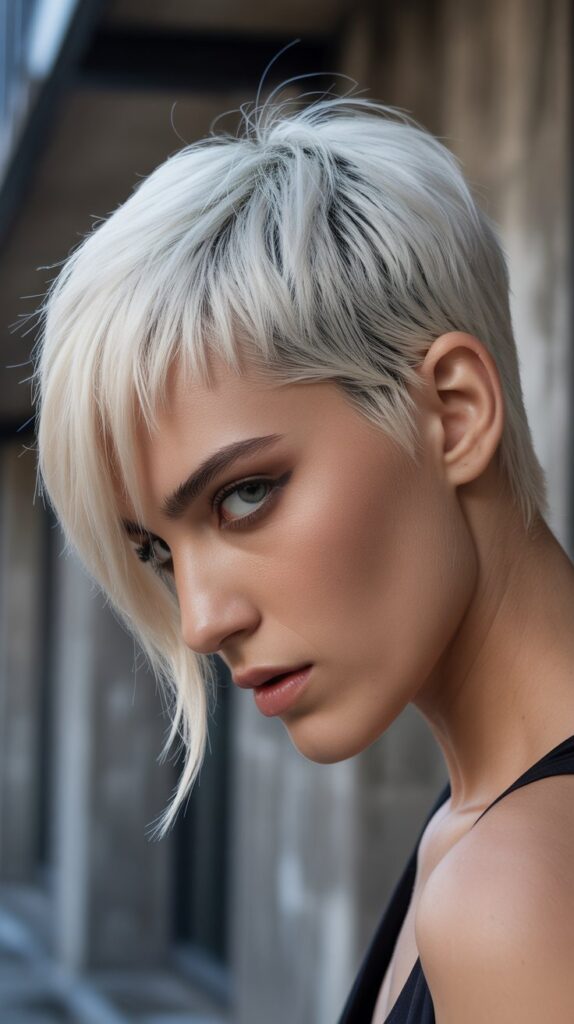
Asymmetrical messy pixie haircuts introduce visual interest through intentional length variation between the left and right sides.
This bold variation creates dramatic angles that complement the textured, undone aesthetic of messy styling.
- The asymmetry typically features one side cut close to the head while the opposite side maintains longer layers that can be swept across the forehead.
- This style particularly flatters square and rectangular face shapes by softening angular jawlines through diagonal lines.
- Bangs in asymmetrical cuts usually start at approximately eyebrow length or longer, providing versatility in styling direction.
- The messiness comes from deliberately styling the longer section in different directions each day, preventing the look from becoming predictable.
- Maintenance involves strategic trimming of the shorter side while allowing controlled growth on the longer side to maintain the asymmetrical ratio.
- Product recommendations include lightweight pomades that provide hold without weighing down the deliberately placed pieces.
3. Choppy Pixie with Razor Cut Edges
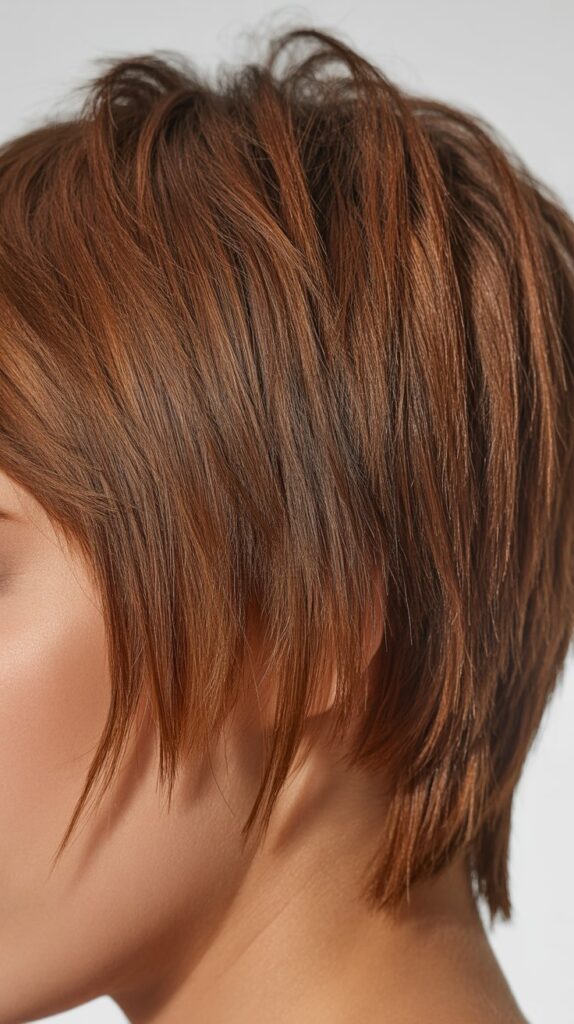
Razor cutting techniques create the ultimate messy pixie by producing irregular, feathered ends that naturally separate and create texture.
This approach differs from scissor cuts by generating softer, more diffused edges throughout the style.
- Razor cuts work best on medium to thick hair textures that can support the additional texturizing without appearing too thin.
- The technique involves using a straight razor or specialized texturizing razor to slice through sections at various angles.
- This creates natural separation between hair strands, resulting in a piecey, intentionally disheveled appearance.
- Styling is remarkably simple, often requiring only finger-combing with a small amount of styling cream to enhance the existing texture.
- The edges soften facial features and create movement that catches light differently than blunt-cut pixies.
- Proper razor maintenance is crucial for this cut, as dull blades can create split ends rather than clean, textured pieces.
4. Messy Pixie with Undercut Design

Combining messy texture on top with precisely shaved or closely trimmed sides creates striking contrast and edge.
The undercut component adds contemporary flair while maintaining the carefree spirit of messy styling.
- The undercut section typically extends from behind the ears around to the nape, though variations can include higher placements reaching the temple area.
- This combination offers practical benefits for those with thick hair, as removing bulk from the sides makes the remaining top section easier to style messily.
- Design possibilities within the undercut range from simple clean shaves to intricate geometric patterns that add personalized artistic elements.
- The textured top section usually measures two to four inches in length, providing enough material to create volume and movement.
- Styling involves focusing product and attention solely on the top section while the undercut remains naturally flat against the scalp.
- Maintenance schedules differ between sections, with undercuts requiring touch-ups every two to three weeks while the messy top follows a standard four to six week trim cycle.
5. Curly Messy Pixie with Natural Texture

Women with naturally curly or wavy hair can embrace messy pixie cuts that celebrate rather than fight their natural texture.
This approach creates dimension and personality through strategic layering that enhances curl patterns.
- Cutting curly hair for a messy pixie requires dry cutting techniques to see how each curl falls naturally and adjust accordingly.
- Layers should follow the curl pattern rather than cutting straight across, which can disrupt the natural formation and create frizz.
- The goal is creating a rounded shape that allows curls to spring outward in various directions without appearing uniform or controlled.
- Product selection focuses on curl-defining creams and leave-in conditioners that enhance natural texture while controlling frizz.
- Diffusing while scrunching upward creates additional volume and emphasizes the messy, lived-in appearance.
- This style particularly benefits those with oval or long face shapes, as the width created by curly texture balances vertical proportions.
6. Platinum Blonde Messy Pixie with Dark Roots
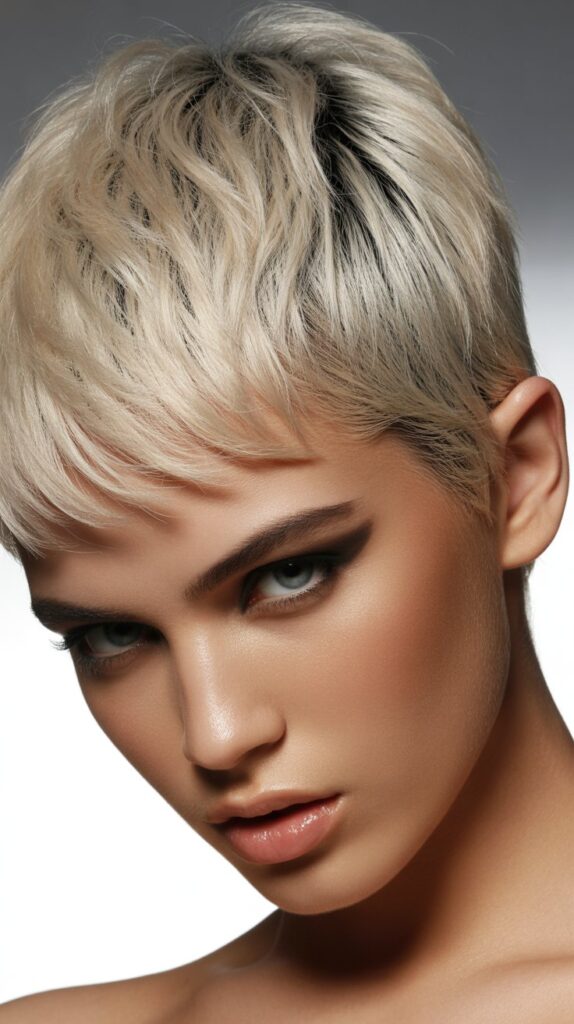
Color contrast elevates messy pixie cuts by adding visual depth and dimension that emphasizes the textured, piece-y nature of the style.
Platinum blonde with intentional dark roots creates an edgy, fashion-forward aesthetic.
- The shadow root technique intentionally leaves one to two inches of natural color at the scalp, creating depth and reducing maintenance frequency.
- Platinum toning requires specialized purple shampoos and regular toning treatments to maintain the bright, cool-toned blonde without brassy undertones.
- The color contrast makes individual textured pieces more visible, enhancing the messy appearance even with minimal styling.
- This dramatic color choice works best with fair to medium skin tones, though adjustments to the blonde shade can accommodate various complexions.
- Maintenance involves root touch-ups every six to eight weeks combined with regular deep conditioning treatments to combat potential dryness from lightening.
- Styling products should be color-safe and free from sulfates to preserve the platinum tone between salon visits.
7. Messy Pixie with Long Front Pieces

Maintaining longer pieces at the front while keeping the back and sides shorter creates versatility in a messy pixie cut.
This variation allows for multiple styling options while preserving the low-maintenance nature of pixie haircuts.
- Front pieces typically measure three to five inches, long enough to tuck behind ears or sweep across the forehead in various directions.
- The length graduation from front to back creates natural movement as shorter pieces support and lift the longer sections.
- This style provides a safety net for those transitioning from longer hair to a pixie, offering some length to style during the adjustment period.
- Versatility includes slicking front pieces back for a sleek look or tousling them forward for maximum messy texture.
- Face shape considerations favor this style for round and square faces, as the longer front pieces create elongating vertical lines.
- Daily styling involves applying texturizing spray primarily to the longer front sections while leaving shorter back sections naturally piece-y.
8. Shaggy Pixie with Feathered Crown
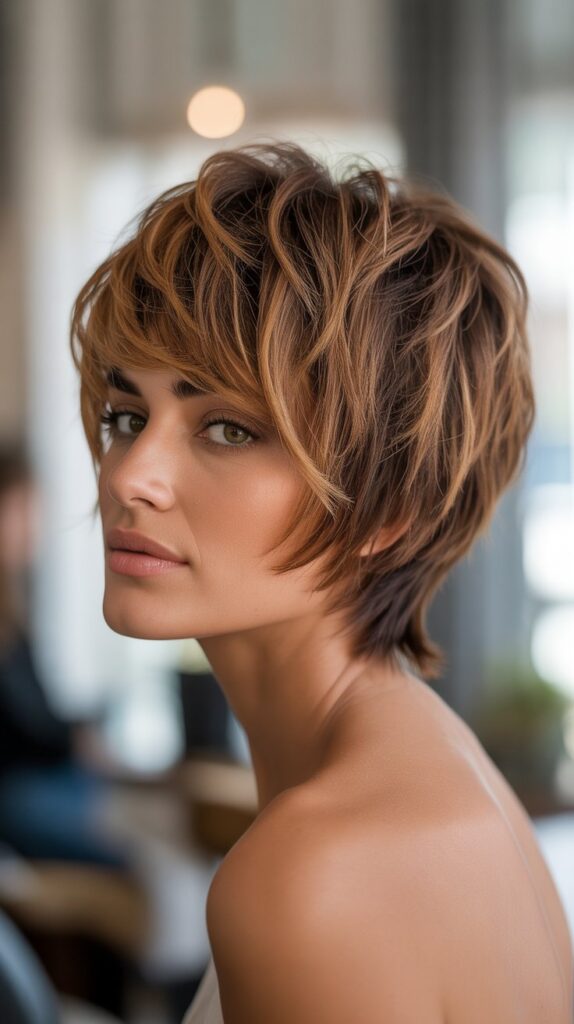
The shaggy pixie takes messy styling to the next level with deliberately uneven layers concentrated at the crown.
This creates substantial volume and movement reminiscent of 1970s shag cuts adapted for contemporary short styles.
- Feathering techniques involve cutting hair at acute angles so ends taper to fine points that naturally flip and separate.
- Crown concentration means the longest, most textured layers sit at the top of the head, creating lift and dimension.
- This style works particularly well for fine to medium hair textures that benefit from the volume-boosting effects of multiple layers.
- The shaggy nature means this cut looks best when slightly overgrown, making it ideal for those who prefer extending time between salon visits.
- Styling requires blow-drying with a round brush at the crown to enhance the feathered, lifted effect, followed by texturizing product application.
- The overall effect creates a youthful, carefree appearance that suits casual and professional environments equally well.
9. Messy Pixie with Tapered Nape
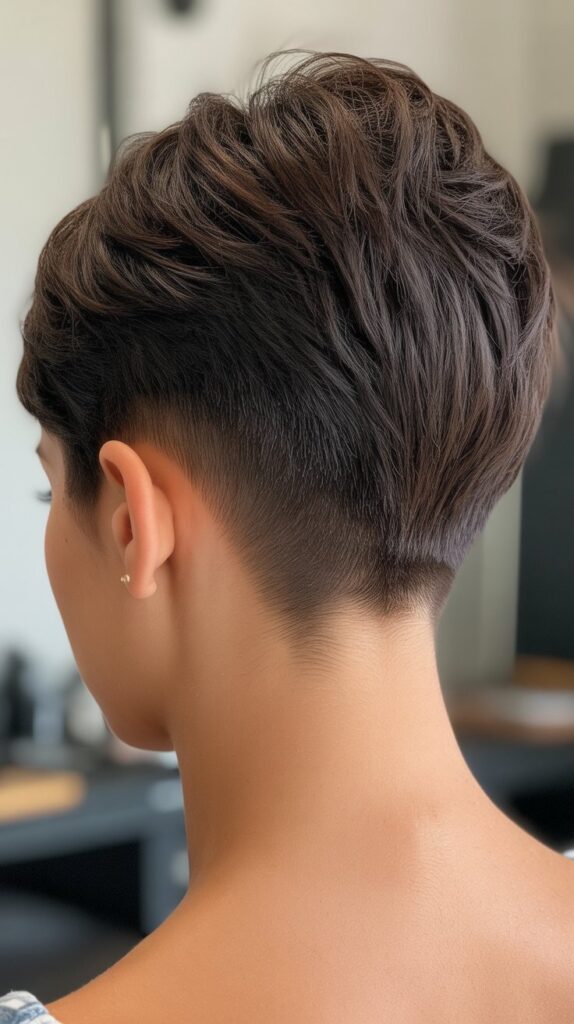
A tapered nape provides clean structure to the back and sides while maintaining messy, textured styling on top. This combination offers the best of both worlds: polished edges with intentionally disheveled volume.
- Tapering involves gradually reducing hair length as it approaches the hairline, creating a subtle fade effect.
- The technique works particularly well for those with thick hair growth patterns at the nape that might otherwise appear bulky.
- This structured back section contrasts beautifully with the deliberately messy top, creating visual interest from all angles.
- Nape maintenance requires more frequent attention than the top section, often needing cleanup every three to four weeks.
- The tapered approach suits professional environments where completely wild styling might be inappropriate, offering controlled messiness.
- Face shape compatibility is nearly universal, as the taper can be customized to enhance neck length and head shape proportions.
10. Messy Pixie with Micro Bangs
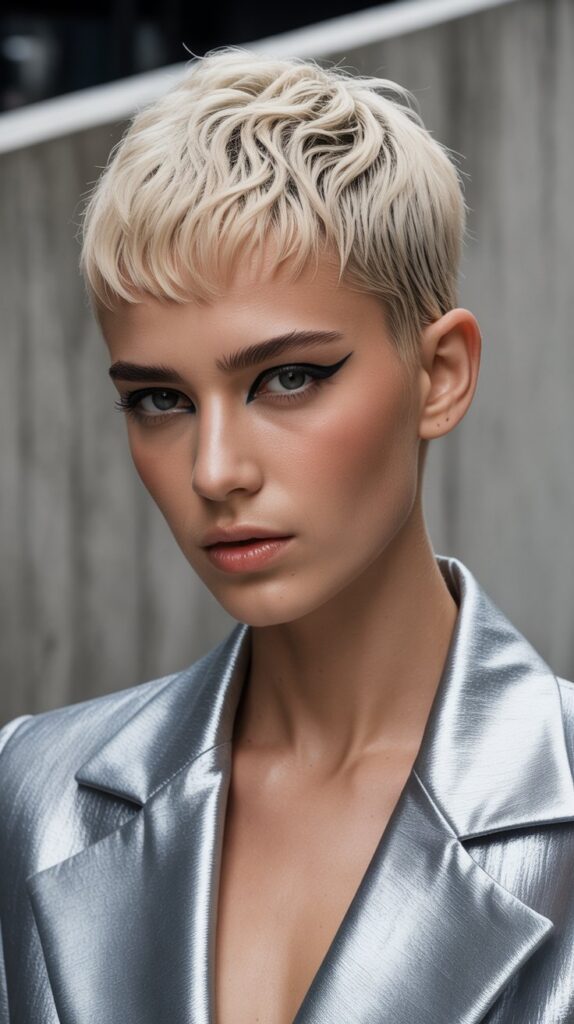
Micro bangs add unexpected edge to messy pixie cuts by creating a short, blunt fringe that contrasts with the textured, piece-y styling throughout the rest of the cut. This bold choice makes a strong fashion statement.
- Micro bangs typically sit one to two inches above the eyebrows, creating a striking horizontal line across the forehead.
- The contrast between the precise, blunt bangs and messy top sections creates intentional juxtaposition that draws attention.
- This style particularly flatters those with oval or long face shapes, as the horizontal line shortens vertical proportions.
- Styling involves keeping micro bangs relatively flat and straight while working texture and volume into the remaining sections.
- Maintenance requires precise trimming of the bangs every two to three weeks to maintain the micro length.
- Face framing considerations include ensuring the blunt bang line complements eyebrow shape and eye placement.
11. Textured Pixie with Side Part
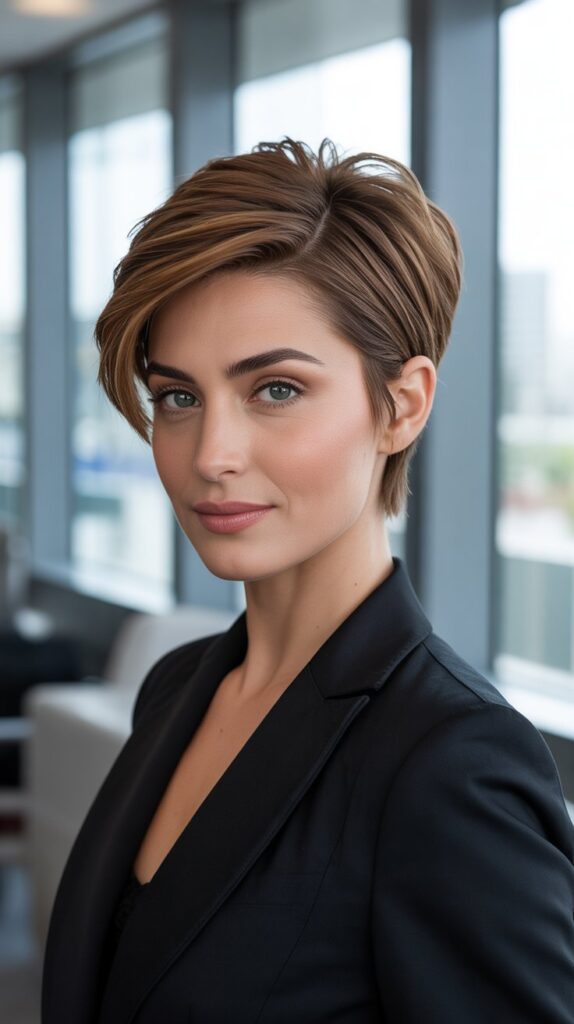
A defined side part adds structure to messy pixie cuts while allowing texture and volume to dominate the overall appearance. This classic styling choice works with the messy aesthetic rather than against it.
- The part placement typically sits approximately one to two inches from the center, creating asymmetry that enhances face shape.
- One side of the part features more volume and length, while the opposite side lies closer to the head for balance.
- This styling approach suits professional environments where some structure is preferred while maintaining contemporary messy texture.
- Product application focuses on the heavier side to encourage volume and piece-y separation while keeping the shorter side relatively smooth.
- The side part can shift position between styling sessions, offering versatility within the same haircut.
- Face shape recommendations include this style for round and square faces, as the diagonal line created by the part adds length.
12. Messy Pixie with Highlighted Tips
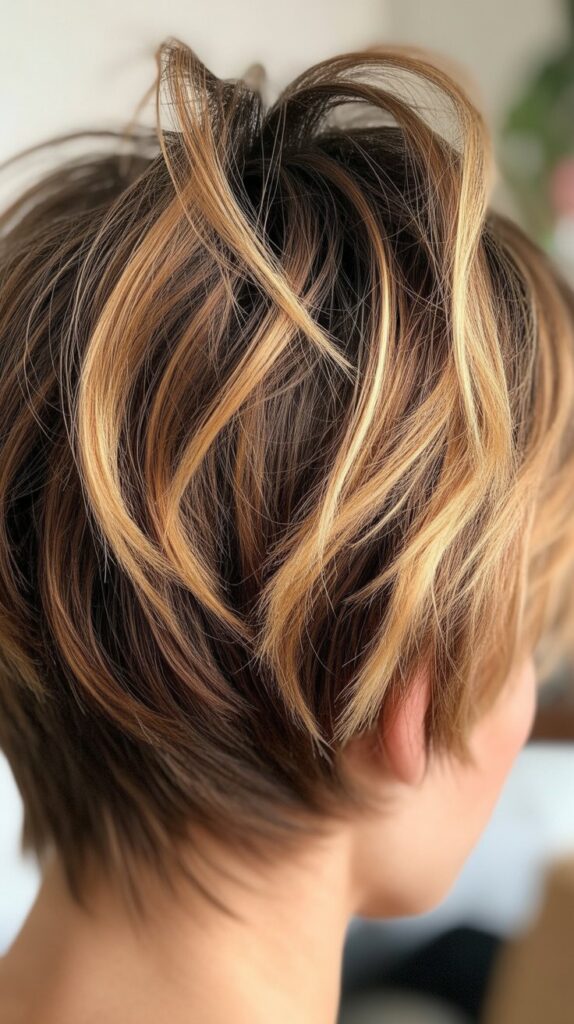
Strategic highlighting of the tips and ends of a messy pixie cut emphasizes the textured, piece-y nature of the style. This color placement technique creates dimension and movement throughout the cut.
- Balayage or free-hand painting techniques apply lighter color to the outermost portions of each section.
- The highlighting creates a sun-kissed effect that makes individual textured pieces more visible and defined.
- Color placement should follow the natural direction hair falls in the messy style, enhancing rather than fighting the intended texture.
- This technique works with any base color, from natural brunettes adding caramel tones to dark hair incorporating subtle burgundy or auburn highlights.
- Maintenance involves toning treatments every four to six weeks to keep highlighted ends vibrant and preventing brassiness.
- The dimensional effect makes fine hair appear fuller and thicker by creating visual depth through color variation.
13. Messy Pixie with Disconnected Layers
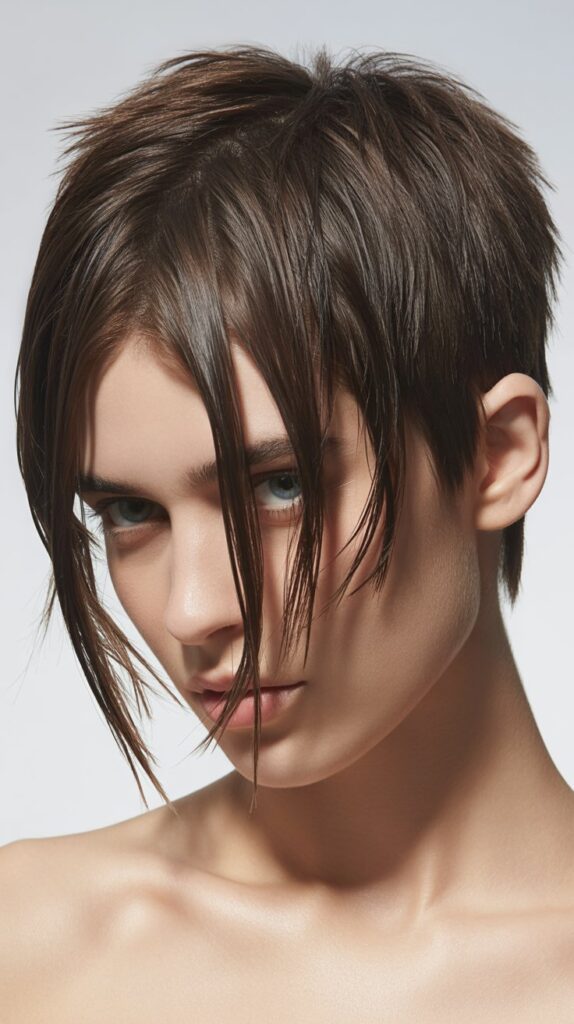
Disconnected layering creates intentional gaps in length throughout a messy pixie cut, producing dramatic texture and separation between sections. This advanced cutting technique generates extreme piece-y styling.
- Unlike traditional graduated layers, disconnected layers feature abrupt length changes that create visible gaps and texture.
- The technique involves cutting individual sections at vastly different lengths without blending them together.
- This approach generates maximum movement and dimension, as each section behaves independently when styled.
- The dramatic texture suits those seeking an edgy, fashion-forward appearance that stands out in any setting.
- Styling involves separating and defining individual sections with strong-hold products to emphasize the disconnected nature.
- Face shape considerations favor this style for those with balanced proportions who can support the dramatic texture without overwhelming features.
14. Messy Pixie for Thick Hair

Thick hair presents unique opportunities for messy pixie cuts, as the abundant density provides substance for dramatic texture and volume. Specialized cutting techniques manage bulk while creating stunning messy styling.
- Thinning and texturizing techniques remove internal bulk without affecting the overall shape or creating holes in the style.
- Point-cutting and notching create ends that naturally separate and move in different directions.
- The weight of thick hair means styles hold their shape well throughout the day with minimal product assistance.
- Layering should be strategic to prevent the top from becoming too heavy and falling flat despite attempts at messy styling.
- This hair type benefits from razor techniques that create softer, more diffused edges throughout the cut.
- Maintenance focuses on regular texturizing treatments rather than frequent full cuts, extending time between salon visits.
15. Messy Pixie for Fine Hair

Fine hair requires specific approaches to achieve messy pixie styling without appearing thin or limp. Strategic cutting and product selection create the illusion of thickness and texture.
- Blunt cutting techniques preserve maximum density by keeping all hair at similar lengths without excessive thinning.
- Layering should be minimal and strategic, focusing on the crown area for lift while maintaining weight at the perimeter.
- Texturizing products formulated for fine hair provide grip and separation without weighing down delicate strands.
- Dry shampoo serves as both a volumizing and texturizing agent, absorbing oil while creating grit that enhances messy styling.
- Blow-drying techniques involve lifting at the roots while directing air flow against the natural hair growth pattern.
- Color treatments, particularly highlighting, create dimension that makes fine hair appear fuller and more textured.
16. Messy Pixie with Baby Bangs
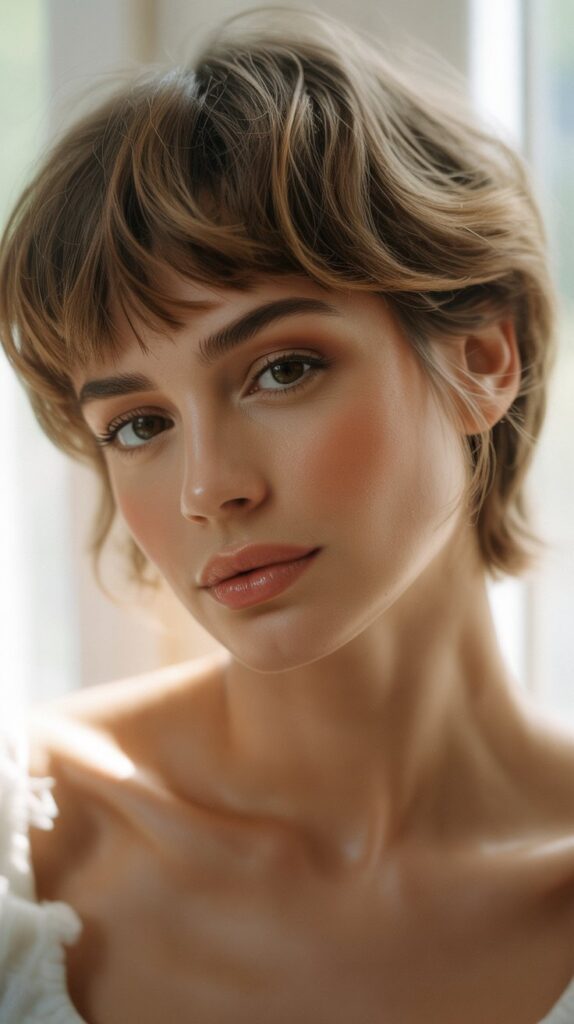
Baby bangs, or wispy short bangs, add a soft, feminine touch to messy pixie cuts. Unlike micro bangs, baby bangs feature thinner, more textured pieces that blend with the overall messy aesthetic.
- Baby bangs typically measure one to two inches long and feature irregular, piece-y edges rather than blunt lines.
- The wispy nature complements the textured messiness throughout the rest of the cut, creating cohesive styling.
- This approach suits those seeking softness and femininity within the edgy pixie cut framework.
- Styling involves minimal intervention, allowing the natural texture and irregular edges to create the desired wispy effect.
- The delicate bangs work particularly well with oval and heart-shaped faces, softening features without overwhelming proportions.
- Maintenance requires gentle trimming to preserve the wispy, irregular nature rather than creating a solid, heavy bang line.
17. Messy Pixie with Mohawk Silhouette
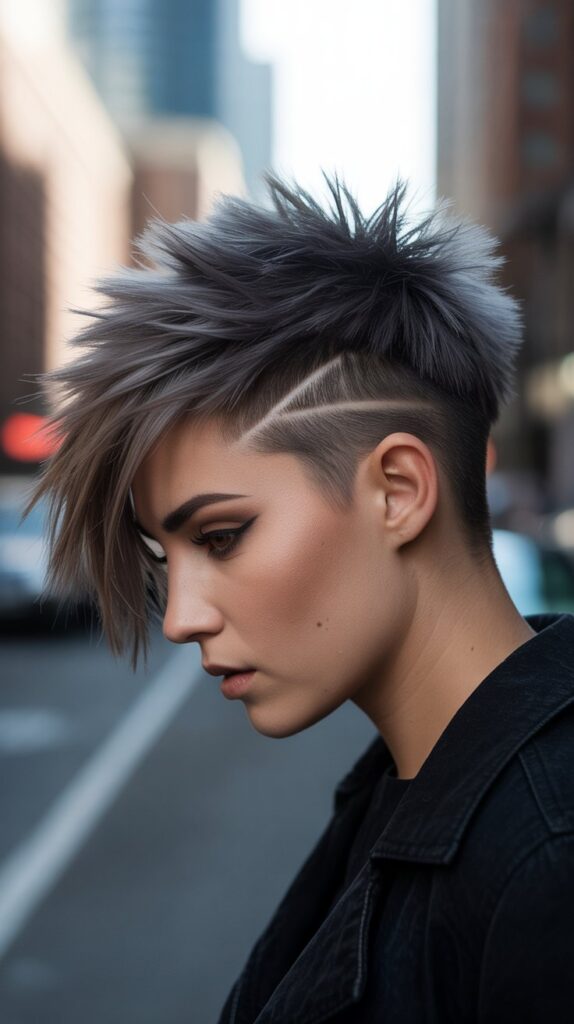
The mohawk-inspired messy pixie features concentrated length and volume along the center of the head from forehead to crown. The sides remain shorter, creating a distinctive ridge-like silhouette.
- The central section typically measures three to five inches in length, substantially longer than the closely cropped sides.
- This dramatic style works best for those seeking maximum impact and aren’t concerned with conventional beauty standards.
- Styling focuses on directing all volume and texture upward and along the central mohawk ridge.
- Strong-hold products like gels or pomades keep the textured mohawk section lifted while sides remain flat.
- The edgy aesthetic suits creative fields and expressive personalities seeking to make bold style statements.
- Maintenance requires regular side trimming every two to three weeks while the central section follows a normal cut schedule.
18. Messy Pixie with Pompadour Volume

Incorporating pompadour volume at the front creates sophisticated height within a messy pixie cut. This vintage-inspired element adds drama and elegance to the contemporary messy texture.
- The pompadour section features hair swept upward and back from the forehead, creating substantial lift and volume.
- This front volume contrasts with the messy, textured sides and crown, creating dimensional interest.
- Achieving the pompadour requires blow-drying the front section upward while it’s damp, followed by strong-hold product to maintain height.
- The style particularly flatters round and square faces by adding vertical height that elongates overall proportions.
- Variations include subtle pompadour height for professional settings or dramatic volume for special occasions and events.
- Maintenance involves ensuring the front section maintains sufficient length to create the desired lift, typically three to four inches.
19. Messy Pixie with Ombre Color
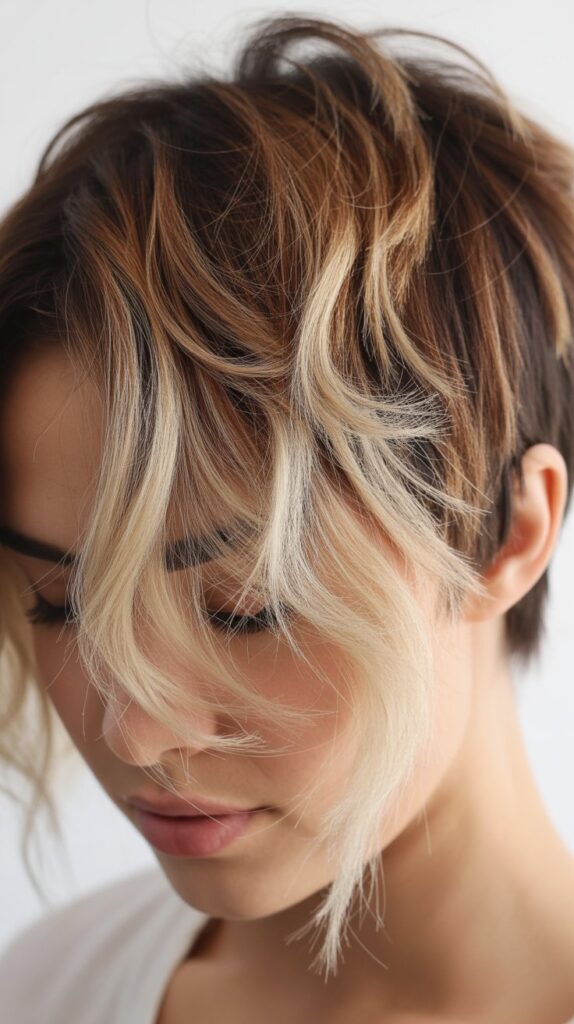
Ombre coloring transitions from darker roots to lighter ends, creating gradual color progression that enhances the textured, piece-y nature of messy pixie cuts.
The color change adds depth and dimension throughout the style.
- The color transition typically begins at ear level or slightly higher, gradually lightening toward the tips and crown.
- Ombre effects work with any color combination, from natural brunette-to-blonde transitions to creative fashion colors.
- The gradual color change makes individual textured pieces more visible and defined, enhancing the messy styling effect.
- This coloring technique requires less frequent maintenance than all-over color, as root growth becomes part of the intentional design.
- Face framing considerations include placing lighter colors around the face to brighten complexion and draw attention to features.
- Toning treatments maintain color vibrancy in the lightened sections without requiring full color reapplication.
20. Messy Pixie with Finger Wave Details
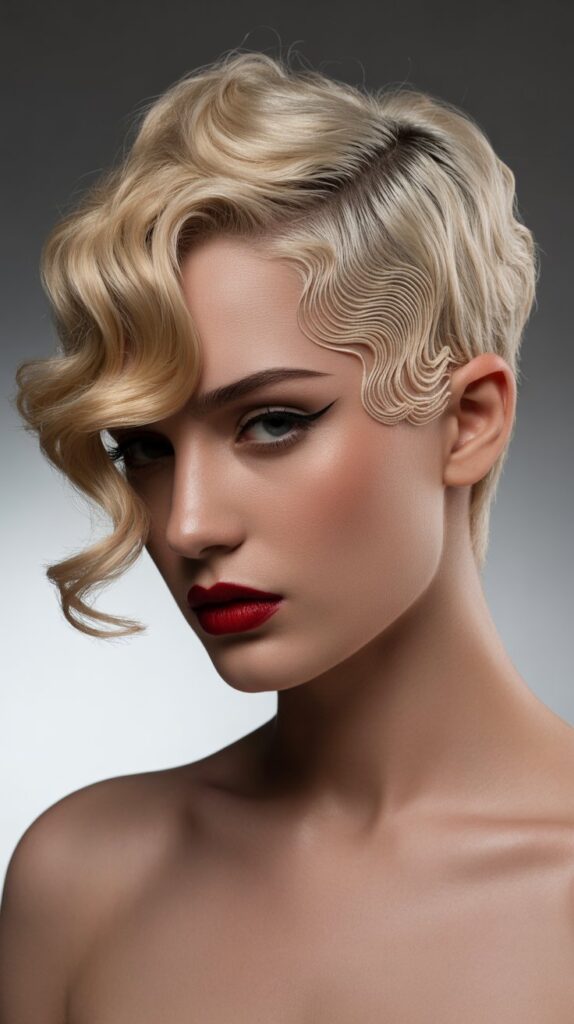
Incorporating finger wave elements into sections of a messy pixie creates unexpected vintage glamour within contemporary styling.
Strategic wave placement adds texture and movement that differs from typical messy approaches.
- Finger waves involve creating S-shaped curves in small sections, typically around the face or along the side part.
- The technique requires setting lotion or gel applied to damp hair, then shaped with fingers and combs before drying.
- This vintage element contrasts beautifully with the deliberately undone messiness throughout the rest of the cut.
- The style suits special occasions, photoshoots, or those who appreciate mixing historical styling techniques with modern cuts.
- Only small sections receive finger wave treatment, preventing the overall look from appearing costume-like or dated.
- The waves add structure and intentionality to what might otherwise appear as purely accidental messy styling.
21. Messy Pixie with Textured Nape
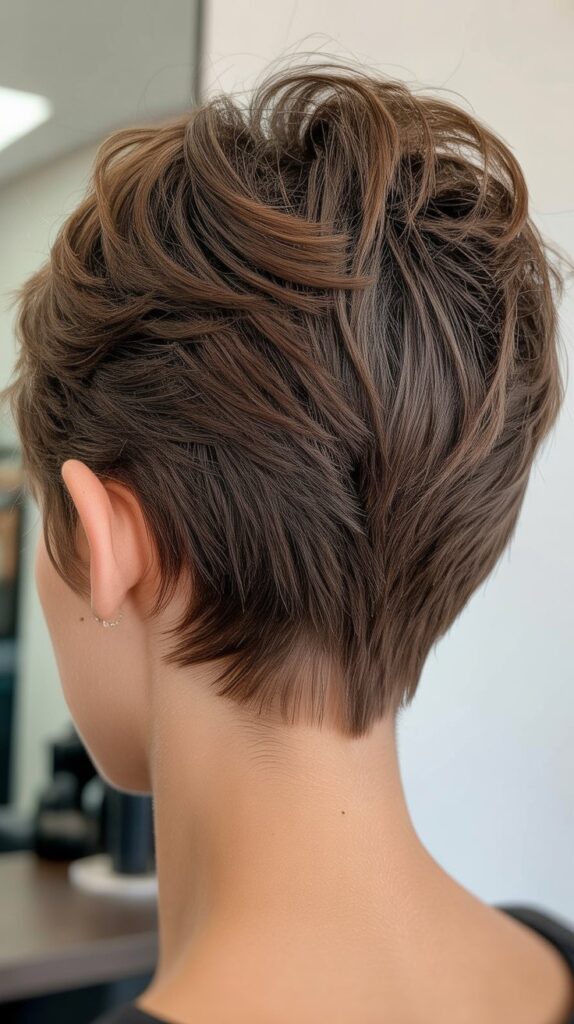
Creating specific texture at the nape involves graduated cutting that produces wispy, piece-y ends at the hairline. This attention to the back section ensures the messy pixie looks intentional from every angle.
- Point-cutting and razor techniques create irregular, feathered ends that naturally separate at the nape hairline.
- The textured nape prevents the back from appearing blunt or too structured compared to the messy top sections.
- This detail particularly benefits those who frequently wear their hair up or pulled back, ensuring visual interest remains visible.
- The wispy nape pieces should gradually taper to fine points that lie naturally against the neck without appearing choppy.
- Maintenance involves careful trimming that preserves the textured, piece-y nature rather than creating a solid line.
- The technique suits all face shapes as it’s primarily about back-view aesthetics and overall style cohesion.
22. Messy Pixie with Crown Volume
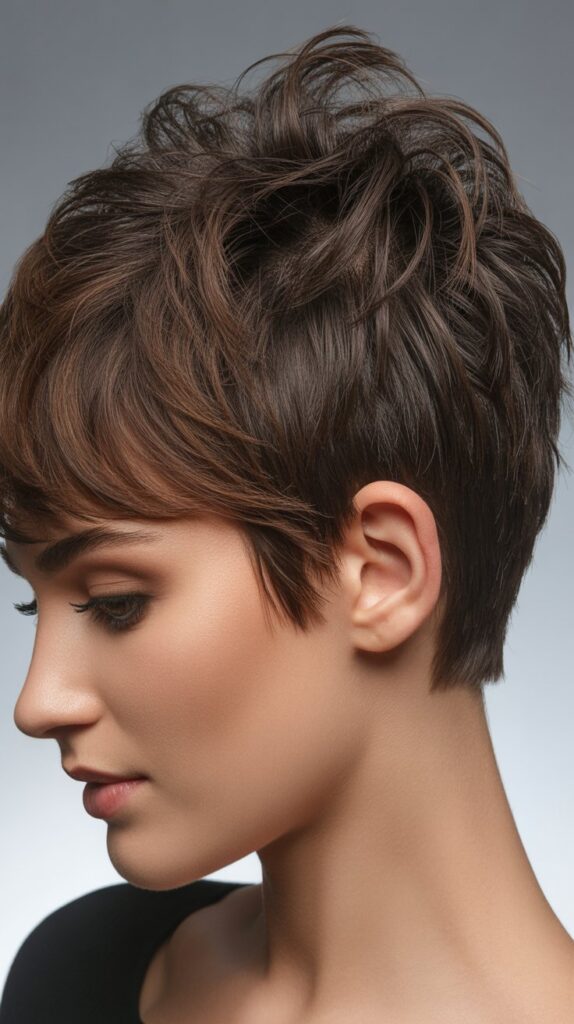
Concentrating volume specifically at the crown creates dramatic lift and dimension in messy pixie cuts. Strategic cutting and styling techniques generate maximum height at the top of the head.
- Achieving crown volume requires the longest layers positioned at the top of the head, typically three to four inches.
- Undercutting or shorter surrounding sections allow the crown to lift freely without being weighed down by neighboring hair.
- Blow-drying with the head upside down or using a round brush at the roots creates foundation volume before styling products.
- Texturizing and volumizing sprays applied at the roots enhance lift while maintaining the messy, piece-y appearance.
- This approach particularly flatters long or rectangular face shapes by adding width and balance to vertical proportions.
- The dramatic volume makes the style suitable for those seeking maximum impact and aren’t concerned with subtle, understated looks.
23. Messy Pixie with Lived-In Color
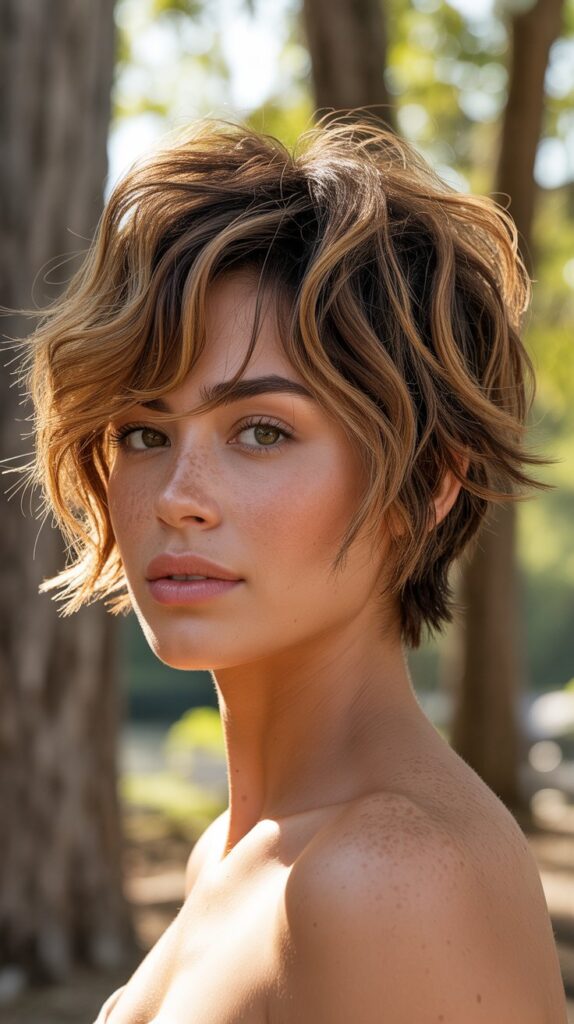
Lived-in color techniques create natural-looking dimension that appears to grow out beautifully, complementing the effortless nature of messy pixie styling. This approach minimizes maintenance while maximizing visual interest.
- Color placement focuses on areas where sun would naturally lighten hair: around the face, at the crown, and on top layers.
- The technique avoids harsh lines or obvious color blocks, instead creating seamless transitions that appear naturally occurring.
- Lived-in color grows out gracefully over several months without requiring frequent salon visits for touch-ups.
- This approach works with any base color and can incorporate subtle highlights, lowlights, or both for maximum dimension.
- The natural appearance complements the deliberately undone messy styling, creating cohesive effortless aesthetics.
- Maintenance involves occasional toning treatments rather than regular color reapplication, making it ideal for low-maintenance lifestyles.
24. Messy Pixie with Wet Look Styling
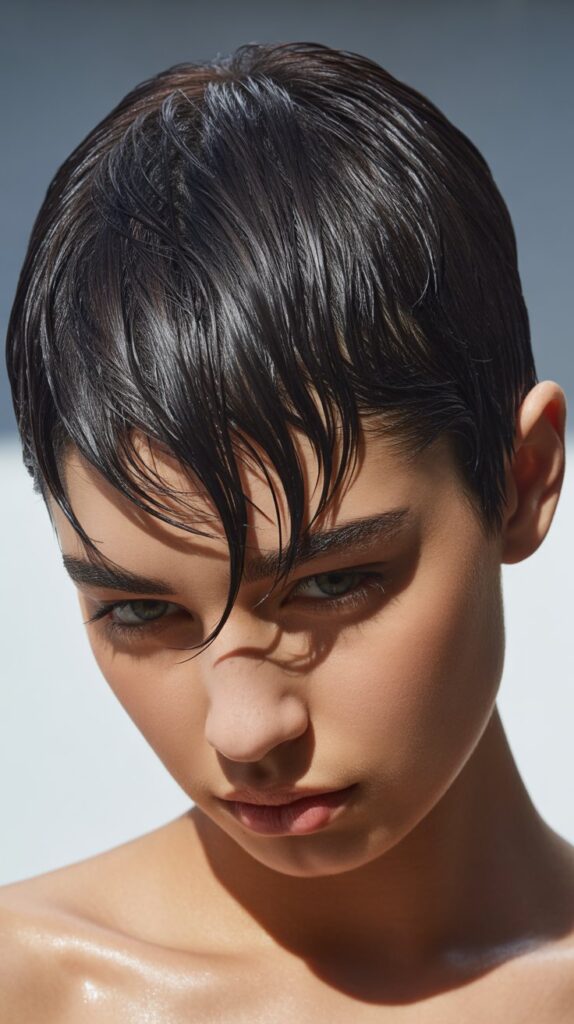
Wet look styling creates sleek, glossy finish on messy pixie cuts while maintaining piece-y separation and texture. This contemporary approach offers an alternative to traditional tousled messy styling.
- Achieving wet look requires generous application of gel or similar strong-hold products to clean, damp hair.
- The product should be worked thoroughly through all sections, then allowed to air dry or dried with a diffuser.
- Despite the sleek, wet appearance, the underlying messy cut ensures texture and separation remains visible.
- This styling works particularly well for evening events or situations requiring polished sophistication with contemporary edge.
- The wet look emphasizes the precision of the underlying cut while the messy texture prevents the style from appearing too controlled.
- Product selection should focus on non-flaking gels that dry with shine rather than creating white residue.
25. Messy Pixie with Face-Framing Pieces

Strategically longer pieces around the face create softness and versatility within messy pixie cuts. These face-framing sections can be styled in multiple ways while maintaining the overall short, textured aesthetic.
- Face-framing pieces typically measure two to four inches, noticeably longer than surrounding hair at the temples and sideburns.
- These sections can be tucked behind ears, swept across cheeks, or styled forward depending on desired look and face shape.
- The longer pieces provide security for those hesitant about extremely short hair around the face, offering some length to style.
- Texturizing these sections creates movement and prevents them from appearing too structured or heavy against the face.
- This variation works particularly well for those with round or square face shapes, as the longer pieces create slimming vertical lines.
- Styling versatility includes slicking pieces back for formal occasions or leaving them tousled for casual, everyday wear.
26. Messy Pixie with Slicked Sides
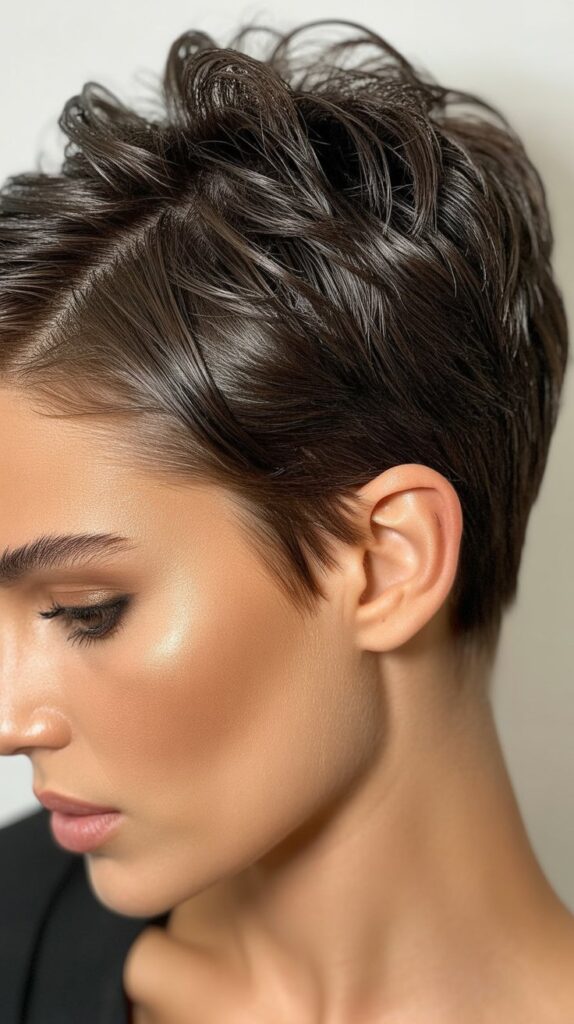
Contrasting slicked-down sides with textured, messy top sections creates sophisticated edge in pixie cuts. This styling approach offers polished structure while maintaining deliberately undone volume on top.
- Achieving slicked sides requires pomade or gel applied to damp hair, then combed smoothly against the head.
- The top section receives opposite treatment with texturizing products that encourage separation and volume.
- This contrast creates visual interest and allows the messy top texture to stand out against the controlled sides.
- The style works well in professional environments where extreme messiness might be inappropriate, offering controlled rebellion.
- Face shape compatibility includes those with balanced proportions who can support the strong horizontal lines created by slicked sides.
- Maintenance throughout the day may require carrying small amounts of product for touch-ups to slicked sections.
27. Messy Pixie with Graduated Layers

Graduated layering creates smooth transitions between lengths throughout messy pixie cuts. Unlike disconnected layers, graduated cuts blend seamlessly while still providing texture and movement.
- Graduation involves cutting each layer slightly longer than the one beneath it, creating stacked effect.
- This technique produces substantial volume at the crown while maintaining controlled perimeter length.
- The smooth transitions ensure the messy styling appears intentional rather than accidentally uneven or choppy.
- Graduated cuts work well for those seeking classic, versatile pixie styling that can be messy or sleek depending on the occasion.
- All hair textures benefit from graduated layering, though techniques may vary based on density and curl pattern.
- Maintenance involves regular trims that preserve the graduation ratio rather than allowing it to grow out into a single-length cut.
28. Messy Pixie with Curtain Bangs
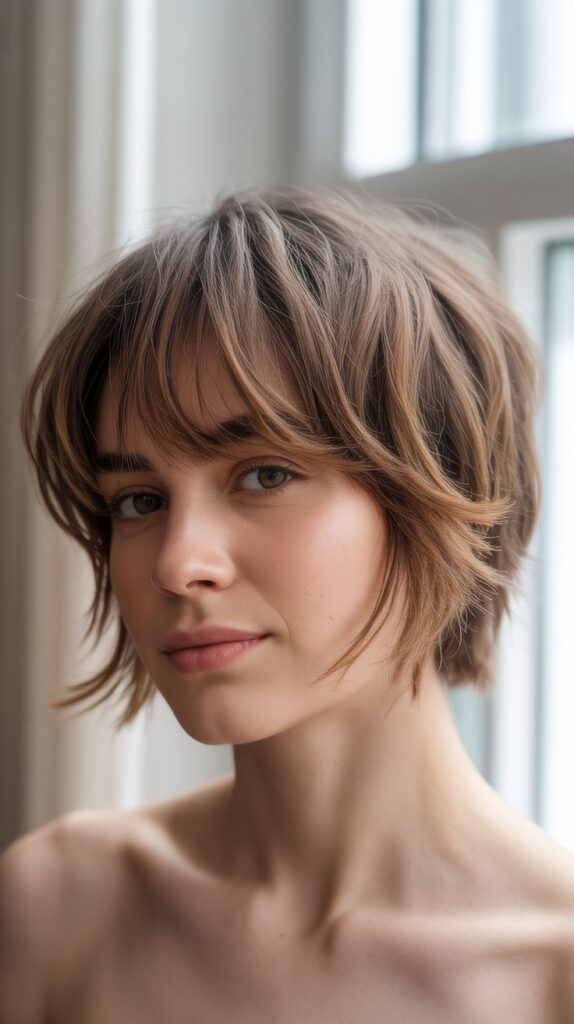
Curtain bangs part in the center and frame both sides of the face, adding softness and vintage inspiration to messy pixie cuts. This bang style offers versatility and face-framing dimension.
- Curtain bangs typically measure two to four inches at the center part, gradually lengthening as they curve toward the temples.
- The parted style creates gentle face-framing that softens features while complementing the textured messy top.
- This approach suits most face shapes, particularly those seeking to minimize forehead width or add softness to angular features.
- Styling involves blow-drying the bangs away from the face on each side, creating the signature curtain effect.
- The bangs blend seamlessly with the rest of the cut, requiring only minimal length difference to create the parted framing.
- Maintenance includes regular bang trims every three to four weeks to maintain the face-framing length without compromising the style.
29. Messy Pixie with Balayage Highlights
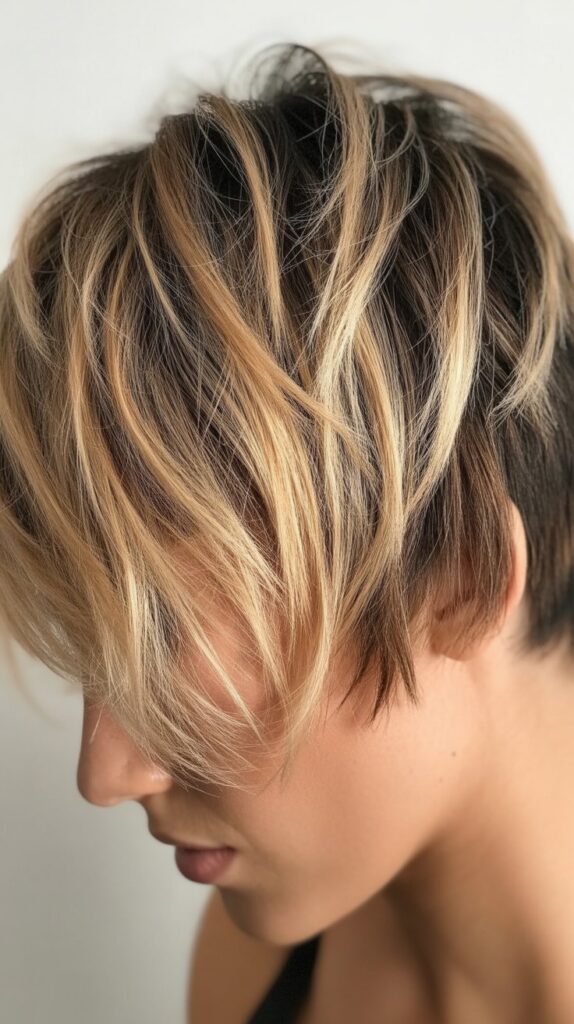
Balayage highlighting techniques paint color onto the surface of the hair, creating natural-looking dimension that enhances textured, messy pixie styling.
This hand-painted method produces customized results that complement individual features.
- The hand-painting technique allows colorists to place highlights precisely where they’ll best enhance the messy texture.
- Lighter pieces around the face brighten complexion and draw attention to features.
- The irregular, natural placement means color grows out beautifully without obvious demarcation lines.
- Balayage works with any base color and any highlight shade, from subtle same-tone highlights to dramatic contrasting colors.
- The technique particularly enhances the piece-y nature of messy styling by creating color variation between separated sections.
- Maintenance involves periodic toning rather than frequent highlight reapplication, typically every three to four months for full refresh.
30. Messy Pixie with Piecey Texture
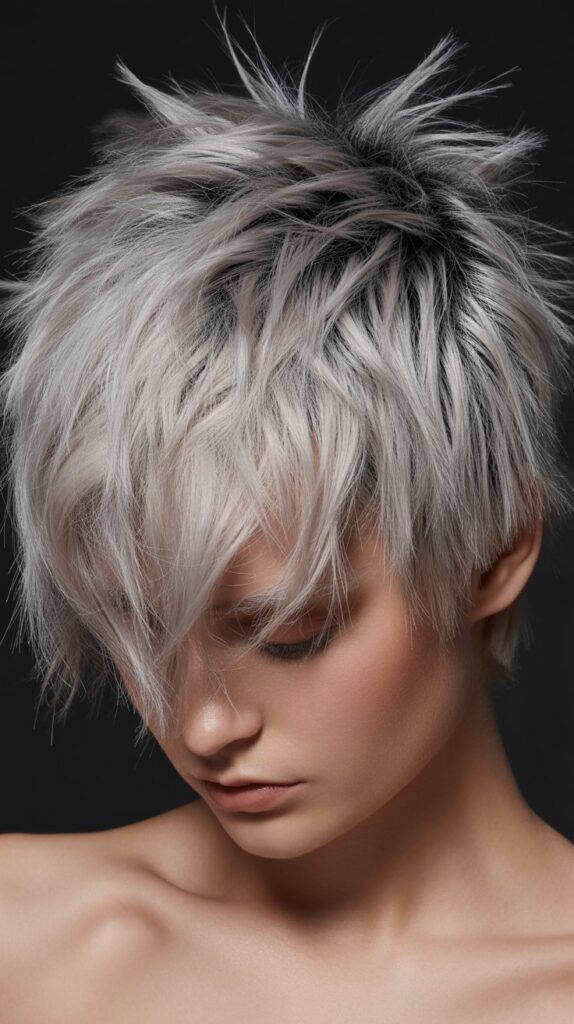
Maximum piece-y texture creates the ultimate messy pixie by ensuring every section separates and moves independently.
This approach requires specific cutting techniques and styling products that encourage definition and separation.
- Achieving extreme piece-y texture requires heavy texturizing during the cutting process, including point-cutting, notching, and possible razor work.
- The cut should remove internal bulk while preserving perimeter density that can be separated into distinct pieces.
- Styling products like fiber creams, texture pastes, or strong waxes provide the grip needed to separate and define individual sections.
- Application involves working product through hair with fingers, deliberately separating sections and directing them in various directions.
- This maximum-texture approach suits those seeking the most dramatic messy styling possible within pixie cut parameters.
- The extreme separation and definition create artistic, editorial-quality results suitable for fashion-forward individuals.
Styling Tips and Product Recommendations
Successfully maintaining and styling messy pixie haircuts requires understanding appropriate products and techniques. Daily styling routines can range from minimal to elaborate depending on desired finish and hair texture.
- Start with small amounts of product and add more as needed, as pixie cuts require less product than longer styles.
- Applying products to damp rather than soaking wet hair provides better control and prevents dilution.
- Focus product application on the areas you want to emphasize, typically the crown and top layers.
- Finger-styling creates more natural, messy results than using combs or brushes, which can over-smooth the intentional texture.
- Experimenting with different product combinations helps discover what works best for individual hair texture and desired finish.
- Blow-drying against the natural growth pattern at the roots creates lift and volume that enhances messy styling.
- Refreshing day-old styles requires only water or refreshing spray followed by re-scrunching to reactivate products.
Maintenance Schedule and Care
Proper maintenance ensures messy pixie haircuts retain their shape and texture between salon visits. Understanding trim schedules and at-home care routines preserves the intentional messy aesthetic.
- Schedule regular trims every four to six weeks to maintain the intended shape and prevent overgrowth that compromises the style.
- Communicate clearly with stylists about maintaining texture rather than creating blunt, heavy lines during maintenance cuts.
- Deep conditioning treatments once weekly preserve hair health without weighing down the messy texture.
- Clarifying shampoo removes product buildup that can flatten texture and prevent messy styling from holding properly.
- Sleeping on silk or satin pillowcases reduces friction that can create unwanted frizz distinct from intentional messy texture.
- Color-treated messy pixies require color-safe products and regular toning appointments to maintain vibrancy and dimension.
- Undercut sections need more frequent maintenance every two to three weeks to keep designs sharp and sides clean.
- Regular scalp massages during shampooing promote healthy hair growth and maintain the foundation for successful messy styling.
Face Shape Compatibility Guide
Selecting the right messy pixie variation for your face shape ensures flattering results that enhance natural features. Understanding proportions helps customize cuts to individual facial structures.
- Oval faces benefit from virtually any messy pixie variation due to naturally balanced proportions.
- Round faces look best with styles that add height at the crown and keep sides sleek to create elongating effects.
- Square faces soften with texture around the jawline and avoid blunt, heavy perimeter lines that emphasize angles.
- Heart-shaped faces balance narrow chins with volume and texture concentrated in lower sections rather than at the crown.
- Long faces benefit from width-creating styles and avoiding excessive height that further elongates proportions.
- Diamond faces showcase high cheekbones with styles that add volume at the temples and crown while keeping sides controlled.
- Personal preference and confidence ultimately matter more than strict face shape rules when selecting messy pixie styles.
Transition Tips for First-Time Pixie Wearers
Transitioning from longer hair to a messy pixie cut represents a significant change that benefits from preparation and realistic expectations. Understanding the process eases the adjustment period.
- Schedule consultations with stylists who specialize in short cuts before committing to the transformation.
- Bring multiple reference photos showing different angles of desired messy pixie styles rather than relying on single images.
- Consider gradual transitions through intermediate lengths like long pixies or short bobs before committing to very short lengths.
- Discuss face shape, hair texture, and lifestyle honestly with stylists to ensure the chosen style suits practical needs.
- Prepare for initial adjustment period where styling new short length feels unfamiliar and potentially frustrating.
- Purchase recommended products before the cut so appropriate styling tools are immediately available.
- Schedule the first follow-up appointment before leaving the salon to ensure timely maintenance and adjustments if needed.
- Remember that hair grows and styles can be modified, reducing pressure to achieve perfection immediately.
- Embrace the freedom and low-maintenance lifestyle that well-executed messy pixie cuts provide.
Styling for Different Occasions
Messy pixie cuts offer remarkable versatility that adapts to various settings from casual to formal. Understanding occasion-appropriate styling techniques maximizes the investment in this bold haircut.
Casual Everyday Styling:
- Apply small amount of texturizing paste to damp hair and air dry for effortless everyday texture.
- Use fingers to tousle and separate pieces randomly without overthinking placement.
- Embrace natural texture and allow hair to dry according to its inherent patterns.
- Minimal product and time investment creates authentic messy styling perfect for daily activities.
Professional Office Settings:
- Incorporate side parts and slicked sides for more structured appearance while maintaining textured tops.
- Use light-hold products that provide control without appearing overly styled or stiff.
- Keep messiness intentional and controlled rather than appearing unkempt or disheveled.
- Focus texture at the crown while smoothing perimeter sections for polished professional presentation.
Evening Events and Special Occasions:
- Add dramatic volume at the crown with teasing and strong-hold spray for glamorous effects.
- Incorporate accessories like decorative bobby pins, small clips, or headbands for elegant touches.
- Consider wet-look styling with gel for sleek, sophisticated evening appearance.
- Enhance with temporary color sprays or glitter for festive occasions and celebrations.
Athletic and Active Lifestyles:
- Use lightweight products that won’t run or drip during physical activity.
- Style with products that maintain hold through sweat and movement.
- Keep styling simple and quick for pre-workout routines with minimal fuss.
- Embrace post-workout tousled texture as part of the authentic messy pixie aesthetic.
Color Techniques That Enhance Messy Pixies
Strategic color placement amplifies the textured, dimensional nature of messy pixie cuts. Understanding various coloring techniques helps select options that complement individual style preferences and maintenance capabilities.
Single Process Color:
- All-over color provides uniform coverage ideal for covering gray or changing base color dramatically.
- Requires regular root touch-ups every four to six weeks to maintain seamless appearance.
- Works well for those seeking simplicity in maintenance routines.
Highlights and Lowlights:
- Multi-dimensional color creates depth that emphasizes textured pieces and messy styling.
- Placement around the face brightens complexion and draws attention to features.
- Requires less frequent maintenance than single process as regrowth becomes part of the dimensional effect.
Fashion Colors:
- Bold shades like pink, purple, blue, or green make dramatic statements suitable for creative self-expression.
- Vibrant colors require special maintenance including color-depositing shampoos and conditioners.
- Fading can be part of the aesthetic, creating evolving looks between salon visits.
Natural Enhancement:
- Subtle highlighting in tones close to natural color creates sun-kissed effects.
- Requires minimal maintenance and grows out gracefully without obvious demarcation lines.
- Perfect for those seeking low-maintenance color that enhances rather than transforms.
Common Mistakes to Avoid
Understanding frequent pitfalls in messy pixie styling and maintenance helps achieve consistently successful results. Learning from common errors saves time, frustration, and potentially disappointing outcomes.
- Over-washing strips natural oils needed for texture, leading to dry, difficult-to-style hair.
- Using too much product weighs down short hair and creates greasy, heavy appearance instead of textured messiness.
- Attempting to use styling techniques designed for long hair that don’t translate to pixie length requirements.
- Neglecting regular trims allows shape to grow out and lose the intentional structure underlying messy styling.
- Choosing a messy pixie based solely on appearance without considering face shape, hair texture, and lifestyle compatibility.
- Styling wet rather than damp hair dilutes products and prevents effective texture creation.
- Using the wrong product types for specific hair texture creates frustration when desired results don’t materialize.
- Comparing results to professionally styled photos without acknowledging lighting, photography, and expert styling involved.
- Giving up too quickly during the learning curve instead of allowing time to master new styling techniques.
- Forgetting that messy pixies are meant to look imperfect, leading to over-styling that defeats the intentional undone aesthetic.
Hair Health and Damage Prevention
Maintaining healthy hair ensures messy pixie cuts look vibrant and style successfully. Understanding preventive care protects against damage from styling products, heat tools, and chemical treatments.
- Apply heat protectant spray before using blow dryers, flat irons, or curling tools to prevent thermal damage.
- Limit heat styling frequency by embracing air-dried texture several times weekly.
- Use sulfate-free shampoos that clean gently without stripping essential moisture from hair and scalp.
- Incorporate protein treatments monthly to strengthen hair structure and prevent breakage.
- Protect hair from sun damage with UV-protective products or hats during extended outdoor exposure.
- Stay hydrated and maintain balanced nutrition to support healthy hair growth from within.
- Avoid aggressive brushing or combing that can cause breakage in textured, piece-y styling.
- Give hair breaks between chemical services like coloring, bleaching, or perms to allow recovery time.
- Trim split ends promptly before they travel up the hair shaft and cause additional damage.
- Choose high-quality styling products without harsh alcohols that dry and damage hair over time.
Celebrity Inspiration and Trend Evolution
Messy pixie cuts have been popularized by numerous celebrities and continue evolving through contemporary fashion trends. Understanding style evolution provides context and inspiration for personal interpretations.
- Iconic pixie wearers throughout history have included Audrey Hepburn, Mia Farrow, and Twiggy who established the cut’s timeless appeal.
- Contemporary celebrities like Charlize Theron, Kristen Stewart, and Zoë Kravitz showcase modern messy pixie variations.
- Social media platforms particularly Instagram and Pinterest drive current messy pixie trends and styling innovations.
- Fashion runways feature editorial pixie cuts that push boundaries and inspire everyday wearable interpretations.
- The trend toward embracing natural texture rather than fighting it has made messy pixies more popular than ever.
- Gender-neutral styling movements have expanded pixie cut popularity beyond traditional boundaries.
- Short hair empowerment movements celebrate the confidence and freedom associated with dramatic hair transformations.
- Seasonal trends influence color choices and styling approaches while the fundamental messy pixie structure remains timeless.
Cost Considerations and Budgeting
Understanding the financial investment required for messy pixie cuts helps with realistic planning and budgeting. Costs vary based on geographic location, salon reputation, and specific services requested.
- Initial consultation fees range from free to $50 depending on salon policy and stylist experience level.
- Tipping conventions typically add 15-20% to service costs for satisfactory results.
- Product costs decrease compared to long hair maintenance as smaller amounts cover short lengths effectively.
- Home maintenance tools like quality blow dryers and round brushes represent one-time investments of $50-$200.
- Geographic location significantly impacts pricing with urban salons charging premium rates compared to suburban locations.
- Stylist experience and reputation justify higher prices through superior cutting techniques and personalized service.
- Package deals or membership programs at some salons reduce per-visit costs for regular clients.
- DIY options for simple trims between salon visits can extend professional cut longevity and reduce annual costs.
Conclusion
The journey through the Best 30 Messy Pixie Haircuts Elevate Your Look reveals the incredible versatility, style potential, and transformative power of this contemporary hairstyle.
From classic tousled variations to bold asymmetrical designs, from subtle professional styling to dramatic evening looks, messy pixie cuts offer something for every personality, face shape, and lifestyle.
The beauty of these cuts lies not just in their striking appearance but in their practical benefits including reduced styling time, minimal product requirements, and the confidence that comes from embracing a bold, fashion-forward choice.
Whether you’re drawn to the textured layers of a shaggy pixie, the edge of an undercut design, the dimension of strategic color placement, or the softness of face-framing pieces, there exists a messy pixie variation perfectly suited to your individual needs and aesthetic preferences.
The key to success involves selecting a skilled stylist who understands short hair cutting techniques, maintaining regular trim schedules that preserve the intentional shape, using appropriate products for your specific hair texture, and most importantly, embracing the imperfect, deliberately undone nature that defines the messy pixie aesthetic.
This comprehensive guide has provided the knowledge, inspiration, and practical advice needed to confidently embark on your messy pixie journey, ensuring your new look not only elevates your style but also reflects your unique personality and enhances your natural beauty for years to come.
